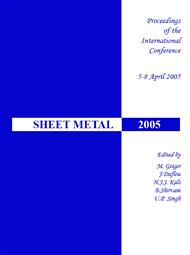[1]
Kahl, M.: Some like it hot. Automotive Manufacturing Solutions (2004), Sept/Oct, 49-52.
Google Scholar
[2]
Kefferstein, R.: Development of Safety and Structural Automotive Parts by Hot-Stamping: Example of the Solution USIBOR 1500 P,. Journées Sidérurgiques Internationales ATS 2004. Paris, 9. - 10. 12. 04.
Google Scholar
[3]
Eriksson, M.: Modelling of Forming and Quenching of Ultra High Strength Steel Components for Vehicle Structures. Luleå University of Technology. Doctoral Thesis LTU-DT 02/19 SE. ISSN: 1402-1544 (2002).
Google Scholar
[4]
Garcia-Aranda, L.: Etude thermo-mécanique et modélisation numérique de l'emboutissage à chaud de l'Usibor 1500. Ecole des Mines de Paris. PhD-Thesis (2004), in French.
Google Scholar
[5]
Lorenz, D.; Roll, K.: Simulation of Hot Stamping and Quenching of Boron Alloyed Steel. 7th Int. ESAFORM Conf. on Mat. Forming, April 28-30 2004, Trondheim, Norway, pp.659-662.
Google Scholar
[6]
Chen, J.: Modelling of Hot Stamped Steel. Great Designs in Steel Seminar 2004. www. autosteel. org/pdfs/gdis_2004_chen. pdf.
Google Scholar
[7]
Åkerström, P.: Material Characterisation for Simulation of Press Hardening. Luleå University of Technology. Licenciate Thesis LTU-LIC 04/28 SE. ISSN: 1402-1757 (2004).
Google Scholar
[8]
Eriksson, M.; Oldenburg, M.; Somani, M.C.; Karjalainen, L.P.: Testing and Evaluation of Material Data for Analysis of Forming and Hardening of Boron Steel Components. Modelling Simul. Mater. Sci. Eng. 10 (2002), 277-294.
DOI: 10.1088/0965-0393/10/3/303
Google Scholar
[9]
Bouaziz, O.; Quidort, D.; Feuillu, D: A Unified Description of Non-Steady State Deformation for Steels in the Austenitic Temperature Range. 41st Thermomechanical Processing of Steels, Liège, Belgique, June (2004).
Google Scholar
[10]
Burte, P.R.; Im, Y.T.; Altan, T.; Semiatin, S.L.: Measurement and Analysis of Heat Transfer and Friction during Hot Forging. Trans. ASME, J. of Eng. for Ind., 112, 332-339.
DOI: 10.1115/1.2899596
Google Scholar
[11]
Malinowski, Z.; Lenards, J.G.; Davies, M.E.: A Study of the Heat Transfer Coefficient as a Function of Temperature and Pressure. J. of Mat. Proc. Techn., 42 (1994), 125-142.
Google Scholar
[12]
Garcia-Aranda, L.; Ravier, P.; Chastel, Y.: Hot Stamping of Quenchable Steels: Material Data and Process Simulations. IDDRG 2003 Conf., Proc. (2003), 155-164.
DOI: 10.4271/2003-01-2859
Google Scholar
[13]
Wang, Z.D.; Qu, J.B.; Liu, X.H.; Wang, G.D.: Influence of Hot Deformation on Continuous Cooling Bainitic Transformation in a Low Carbon Steel. Acta Metallurgica Sinica (English letters). 11 (1998) 2, 121-127.
Google Scholar
[14]
Hanlon, D.N.; Sietsma, J.; van der Zwaag, S: The Effect of Plastic Deformation of Austenite on the Kinetics of Subsequent Ferrite Formation. ISIJ International 41 (2001) 9, 1028-1036.
DOI: 10.2355/isijinternational.41.1028
Google Scholar
[15]
Somani, M.C.; Karjalainen, L.P.; Eriksson, M.; Oldenburg, M.: Dimensional Changes and Microstructural Evolution in B-bearing Steel in the Simulated Forming and Quenching Process. ISIJ International, 41 (2001) 4, 361-367.
DOI: 10.2355/isijinternational.41.361
Google Scholar
[16]
Umemoto, M.; Hiramatsu, A.; Moriya, A.; Watanabe, T.; Nanba, S.; Nakajima, N.; Anan, G.; Higo, Y.: Computer Modelling of Phase Transformation from Work-hardened Austenite. ISIJ International 32 (1992) 3, 306-315.
DOI: 10.2355/isijinternational.32.306
Google Scholar
[17]
Serajzadeh, S.: Modelling the Temperature History and Phase Transformations during Cooling of Steel. J. of . Mat. Proc. Techn. 146 (2004), 311-317.
DOI: 10.1016/j.jmatprotec.2003.11.010
Google Scholar
[18]
Babu, S.S.; Goodwin, G.M.; Rohde, R.J.; Sielen, B.: Effect of Boron on the Microstructure of Low-Carbon Steel Resistance-Seam Welds. Welding Journal 77 (1998), 249-253.
Google Scholar


